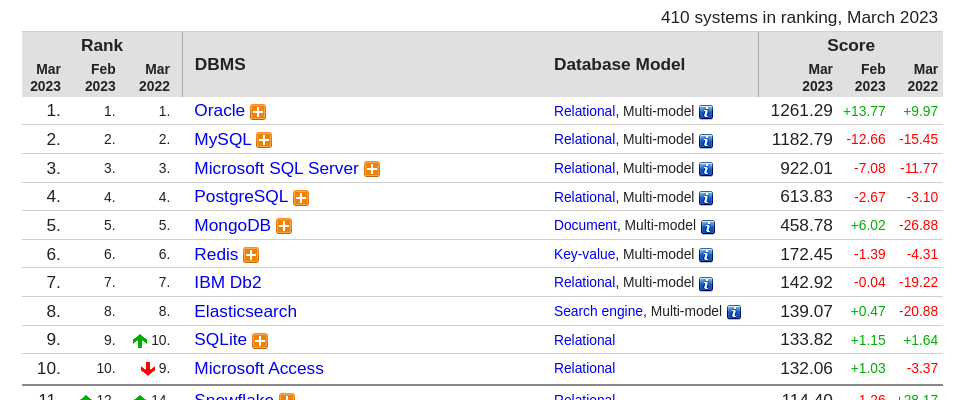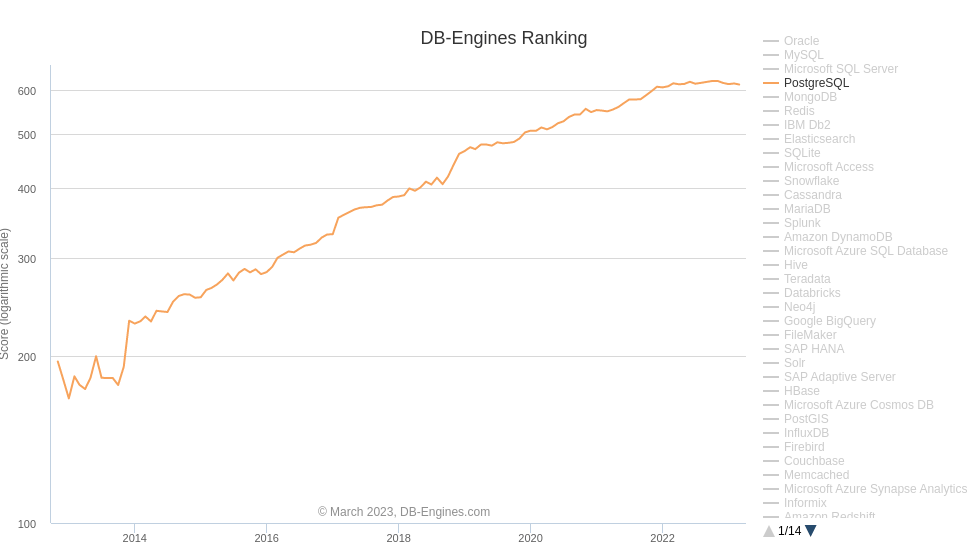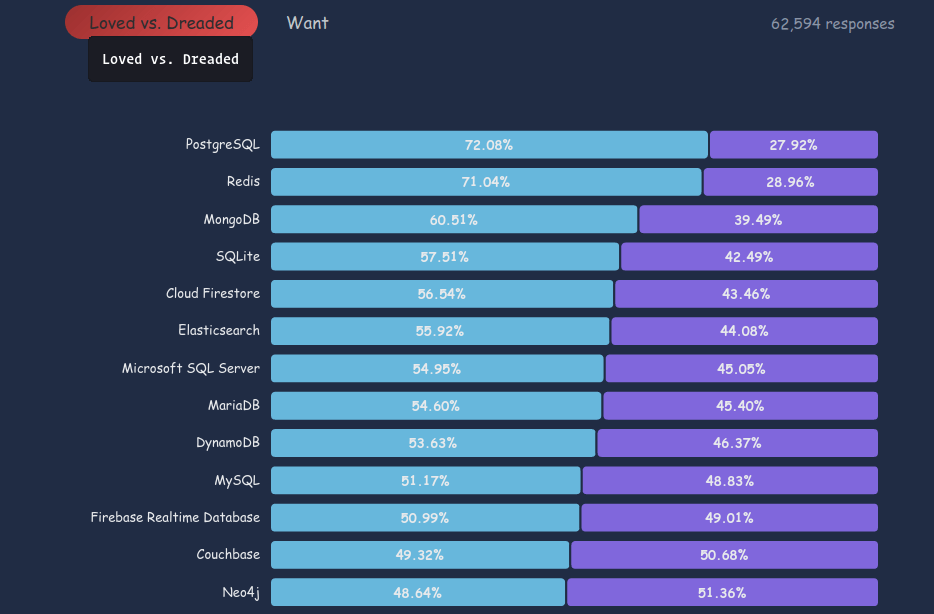In our previous article, we introduced databases and their fundamental features. We also provided a brief history of PostgreSQL, tracing its evolution from a research project at UC Berkeley to its current status as a popular database system across multiple industries and applications.
In this post, we will delve deeper into the reasons behind PostgreSQL’s popularity as a database management system (DBMS), and explore why it is preferred over other databases such as MySQL or Oracle.
Why Is PostgreSQL Becoming More Popularity
PostgreSQL has been gaining popularity over the years due to its various features and benefits. According to DB-Engines website statistics, PostgreSQL is one of the most popular database management systems (DBMS) in the world. It has consistently been in the top 5 DBMS for the past few years, and its popularity has been growing steadily.

Perhaps you can see the exponential growth of PostgreSQL databases from the following figure:

As per the Stackoverflow Survey, PostgreSQL was the most loved RDBMS in 2022.

In 2023, investing time in learning PostgreSQL is a wise decision, whether you seek job opportunities that demand PostgreSQL expertise or intend to utilize it for your own projects.
Open Source Nature
One of the reasons for PostgreSQL’s popularity is its open-source nature. Unlike other DBMSs like Oracle or MySQL (which say they are open source, but in reality, they are under corporate control), you can easily download the source code of PostgreSQL, which is written in C language.
PostgreSQL is licensed under the BSD License, which means that it may be used in open-source and commercial applications for free, making it immune to various versions (for different licenses) whatever the demand is.
In addition to offering the PostgreSQL source code, PostgreSQL makes adding extensions to a database simple with custom aggregates, data types, scopes, and operators. All-text indexing, matching fuzzy clauses, and OpenGIS are just a few of the numerous packages developed on PostgreSQL.
Scalability
Another reason for PostgreSQL’s popularity is its scalability, which can handle large amounts of data and can be easily scaled up or down to meet the needs of any business. Additionally, PostgreSQL has excellent support for ACID (Atomicity, Consistency, Isolation, and Durability) compliance, ensuring data consistency and reliability.
PostgreSQL’s extensibility is another reason why it is so popular, which provides an extensive range of extensions, which can be used to add features and functionality to the DBMS. For example, PostgreSQL supports the integration of geospatial data through extensions like PostGIS, making it a popular choice for location-based applications.
Data Integrity
Data integrity is a top priority for PostgreSQL developers, when introducing new features, they ensure that they do not interfere with data integrity. Even if a new feature promises better performance and speed, it is not allowed if it compromises data integrity.
The developers believe that there is no point in having a fast database that cannot be trusted. Hence, they prioritize correctness over speed, ensuring that PostgreSQL works correctly before focusing on making it faster.
What Is a Relational Database Management System (RDBMS)
A relational database is a collection of data that is organized into tables, each of which represents an entity or relationship between entities. An RDBMS is a software system that allows users to create, modify, and manage relational databases. An RDBMS enforces rules and constraints on the data, ensuring that it is accurate and consistent.
Postgres SQL Data Model
The Postgres SQL data model is a popular data modeling language used to design and implement relational databases. It allows users to define and manipulate data within the database, and to perform complex queries and analyses on the data. The Postgres SQL data model is based on a set of rules known as Normalization Rules, which are used to ensure that the data is well-structured and can be easily queried.
Entities and Relationships
In the Postgres SQL data model, entities are represented as tables, and relationships between entities are represented as foreign keys. A foreign key is a column within a table that points to the primary key of another table. This creates a link between the two tables, allowing data to be shared and queried across multiple tables.
Normalization
The Postgres SQL data model is based on several normalization rules, known as normal forms. These normal forms are used to ensure that the data is well-structured and can be easily queried.
Some of the most common normalization rules include:
- First Normal Form (1NF) – This rule requires that each table in the database has a primary key and that all data in the table is atomic (i.e., indivisible).
- Second Normal Form (2NF) – This rule requires that each non-primary key column in a table is functionally dependent on the primary key.
- Third Normal Form (3NF) – This rule requires that each non-primary key column in a table is not functionally dependent on any other non-primary key column.
Postgres SQL data model and RDBMS are essential components in modern-day data management. They provide an organized and efficient way to store, access, and manipulate data, and are widely used in various industries for their flexibility, scalability, and ease of use.
Understanding the Postgres SQL data model and its underlying principles is crucial for developers and data analysts who want to create and manage high-quality, efficient databases.
Unstructured Data in PostgreSQL
PostgreSQL provides several ways to store and manage unstructured data. In this section, we’ll explore some of the methods used to store unstructured data in PostgreSQL.
Large Object (LOB) Data Type
PostgreSQL provides a Large Object (LOB) data type that can store unstructured data such as text, images, audio, and video. The LOB data type can store data up to 4 TB in size and is ideal for storing large files.
LOB data is stored separately from the table, allowing faster data retrieval and manipulation.
HStore
HStore is a key-value data type that can store unstructured data in PostgreSQL. HStore stores data as key-value pairs in a single column of a table, allowing for flexible storage and retrieval of unstructured data.
HStore supports indexing and querying of key-value pairs, making it ideal for storing and retrieving data quickly.
JSON and JSONB
PostgreSQL supports both JSON and JSONB data types for storing unstructured data. JSON is a text-based data format that represents data as a collection of key-value pairs.
JSONB is a binary format that allows for faster indexing and querying of JSON data. Both JSON and JSONB can store nested data structures, making them ideal for storing complex unstructured data.
Array Data Types
PostgreSQL supports array data types that can store unstructured data such as text, images, and audio. Arrays can store multiple values of the same data type in a single column, allowing for flexible storage of unstructured data.
PostgreSQL provides several ways to store and manage unstructured data, including Large Object (LOB) data type, HStore, JSON and JSONB data types, and array data types.
These methods allow for flexible storage and retrieval of unstructured data, making PostgreSQL an ideal database management system for handling both structured and unstructured data. By leveraging these features, developers, and data analysts can efficiently store, manipulate, and analyze unstructured data in PostgreSQL.
Why We Should Use PostgreSQL Database
In the previous section, we explored the unique features and properties of PostgreSQL. Now, let’s answer the critical question: why and when should we use Postgres?
To answer this question, we need to differentiate between beginner users and medium-to-advanced users.
- For beginner users, ease of installation and use is crucial. PostgreSQL is a great option in this regard, and you will experience this firsthand when you begin installing and working with it.
- For medium users, PostgreSQL provides an efficient way to manage performance and memory, write clear queries, and execute them quickly. This makes it a top choice for many developers and companies.
- For advanced users, Postgres offers the flexibility to create custom methods or modify fundamental aspects of the database engine to meet specific application needs. It’s no surprise that industry giants like Red Hat, Amazon, and Yahoo! have relied on Postgres to develop their databases.
Conclusion
In conclusion, PostgreSQL is a versatile database management system that caters to the needs of developers of all levels. Whether you’re a beginner, a medium user, or an advanced developer, Postgres has unique advantages that make it a popular choice for various industries and applications.
PostgreSQL is a popular choice for many database management system users, and this lesson explored some of the features and advantages that make it stand out. Whether you are a beginner or an advanced user, PostgreSQL offers many benefits that can help you manage and customize your data effectively.
